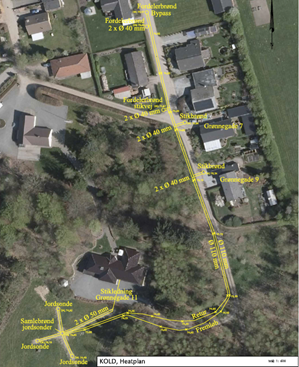Thermonet as rural collective heating in Grønnegade, Skjoldbjerg, DK.
5G network

Picture credits: GeoDrilling
Facts at one glance
Status of the project:
Commercially operating
Operation mode:
Heating network
Geothermal source:
Shallow / Ambient Geothermal
Max heat capacity:
< 1MW
Network generation:
5G
Year of operation start:
2017
Contact:
kontakt@termonet.dk
Description of the project
The thermonet in Skjoldbjerg was established in 2017, and connects three existing houses. It was initiated in relation to the project “Rural Collective Heating”, though it was not financed through the project.
The three houses of varying sizes (102 m2, 116 m2 and 455 m2) connected to the thermonet, have a total consumption of approximately 76 MWh per year. This corresponds to four standard houses. The two smaller homes have a 8 kW heat pump, while the largest home has a 16 kW heat pump installed.
The thermonet consists of three 90 meters depth drillings, and 500 meters horizontal pipes with a diameter of 110mm. The entire thermonet is planned to be able to supply the approximately 20 houses located on Grønnegade, though it would require additional drillings.
Highlights of the project
By establishing a common thermonet, 20% of the price per standard house, compared to an individual geothermal heating solution, was able to be saved.
The owners of the houses were very willing to change to heat pumps, mainly because of the environmental impact.
This case proves, that thermonet can start off at a small scale, and expand gradually afterwards by connecting more houses. This makes thermonet resistant to changes in both growth and reduction of heat sources.
The case also shows how synergies can arise by utilizing excess capacity, which betters the investment costs.
The type of pipes used in the themonet makes it competitive, as the depreciation period of the pipes of at least 30 years, lowers the price of heating.
The biggest challenges / obstacles
Establishing a thermonet in existing housing makes for different challanges than with new contruction. The thermonet would have to cross multiple properties, and the digging proved troublesome as it would have to be established in a protected forest area, while avoiding unlocated wires underground.
Air in the system, which is typical with a thermonet, was a minor problem. It was solved by placing a buffer container with brine and an automatic ventilation, higher than the problem area, hereby slowly removing the air from the system.
Detailed characteristic of the project
Site description
Address
Grønnegade, 6623 Skjoldbjerg Vorbasse, Denmark
Status of the project
Commercially operating
Year of operation start
2017
Type of geothermal Heating / Cooling network
Heating network
Type of geothermal technologies involved
Shallow / Ambient Geothermal
Are heat pumps used within this project?
yes - located at the clients
Heating network generation
5G
Number of clients supplied
< 10
Depth range
1-90
Involved companies
Owner / operator
GeoDrilling
Planner / installer
GeoDrilling
Driller
GeoDrilling
Types of used geothermal sources
Source
Depth range
Temperature range
Purpose
Soil/rock - closed loop
< 20 meters
< 20°C
Heat extraction
Soil/rock - closed loop
20 - 400 meters
< 20°C
Heat extraction
System design
Heat sources included in the network
Monovalent - geothermal energy is the only heat source
Max heating capacity supplied by geothermal energy
< 1MW
Share of geothermal energy
60% - 70%
Annual operation hours for heating
2000 hours - 4000 hours
Annual heating production
< 1 GWh
Annual heating production share
60% - 70%
Energy conversion factor linked to the use of geothermal energy
< 5
Heat source for peak load supply
Geothermal
Has backup system?
Yes
Backup system
Electricity
Share of fossil fuels for annual gross heat production
0 %